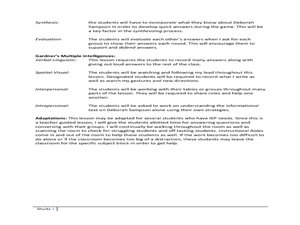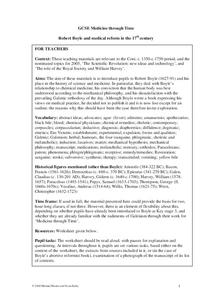Student Handouts
Why Does an Author Write?
To get to the heart of a writer's purpose, just remember to have some PIE (Persuade, Inform, or Entertain)! And appropriately, here is a PIE chart that leaves room for pupils to identify each letter of the acronym and any other ideas or...
EngageNY
Grade 9 ELA Module 3, Unit 3, Lesson 3
Plagiarism is the theft of intellectual property. To avoid this crime, class members learn how to create a works cited page and how to craft in-text citations. After examining a high-performance model paragraph and an example of a works...
University of North Carolina
Comparing and Contrasting
Not all compare and contrast assignments have writers compare and contrast in the same way. Some only ask for comparisons, others only ask for contrasts, and many require more focus than a simple list of similarities and differences....
University of North Carolina
Poetry Explications
Explication may sound like a fancy word, but it's just a fancy way to say analysis. Using a handout on poetry explications, part of a larger series on specific writing assignments, writers learn how to break down and analyze a poem. The...
Newseum
Disinformation Nation: Separating Politics and Propaganda
Separating political rhetoric from propaganda is no small feat. Class members are challenged to examine two different sources about a candidate in an upcoming election and determine whether the primary purpose of the source is to inform...
Curated OER
Waterfalls
Third graders practice identifying the main idea and supporting details when reading informational text. They read text related to waterfalls and practice note taking skills to identify critical details. Students use their notes to...
Curated OER
Do You Know Deborah Sampson?
Fifth graders apply information about Deborah Sampson to create a Jeopardy type game. In this Deborah Sampson lesson, 5th graders read information text about the Revolutionary War Patriot before using the information to develop questions...
Curated OER
Organizing Information into an Outline
Learners explore outlines. In this nonfiction comprehension and study skills instructional activity, students complete a traditional outline for the book Animal Homes by Ann O. Squire following guided instruction as the teacher models...
Curated OER
School Newspaper
Fifth graders run a school newspaper on a school website and discover how to use various literary forms as they relate to the writing process. In this school newspaper lesson, 5th graders synthesize information from different sources,...
Channel Islands Film
Lone Woman of San Nicolas Island: Lesson Plan 1
As a practice writing test, fourth graders use the West of the West's documentary Lone Woman of San Nicolas Island and two print resources as source materials for an informative article that identifies information that is historically...
Curated OER
Comparing Themes Across Texts
Read various texts to compare the themes across each text. Learners write a journal entry describing the most beautiful scenery they've seen and use a map of the United States to locate the Sequoia National Park and Muir Woods. They then...
Curated OER
Text as Object and Art: Aesthetic Impact on Audience Reception of Books in the Early Renaissance and Today
Tenth graders examine the role that aesthetics play in the publication of books. In groups, they apply the concept of physical affectation on each reader's experience to literature. They also compare and contrast the varied types of...
Curated OER
Guided Reading: What Is Government?
Learn about the government's role in everyday life in a guided reading activity. Groups create a KWL chart concerning the government's impact on the community.
Curated OER
Classifying Information About a Main Idea
Elementary learners explore language arts by completing a text identification activity. They discuss the importance of a main idea in a story or paper and how to present it properly. Then they practice identifying the main idea in sample...
Maine Content Literacy Project
Exploring Text with the iMovie Application
Get your class going on one of the final assessments for a unit on short stories by introducing iMovie and its main features. In this tenth instructional activity in a series of fourteen, pupils take some time to explore iMovie before...
Curated OER
Sharing Information: Schools, Police and FERPA
Students research Family Educational Rights and Privacy Act (FERPA), interview school officials to see how FERPA is interpreted in local schools, speak with community journalists to find out if they have ever had a hard time getting...
Curated OER
Applying SQ3R to Texts
After a review of the SQ3R strategy, readers use the provided prompts to respond to a text. The value of this worksheet is in the additional questions that move the learner into higher levels of reasoning.
Mr. Nussbaum
Christopher Columbus
A short informative text features the European explorer, Christopher Columbus. Scholars read or listen to the text then answer ten fill-in-the-blank and multiple-choice questions.
Curated OER
Pebbles, Sand and Silt -- Categorizing Fiction and Informational Books
Primary readers complete the activities in a Pebbles, Sand and Silt FOSS kit. As a class, they are given a group of rocks and they are to categorize them based on their activities in the FOSS kit. They use this information and apply it...
Curated OER
Colonials & Revolutionaries: Background Historical & Cultural Information
The four major trends of the 18th century (The Enlightenment, the Great Awakening, British global ambitions, and economic disagreements) are the focus of a PowerPoint that places in context such influences as deism, mercantilism,...
Michael Hunter and Fiona Kisby
Robert Boyle and Medical Reform in the 17th Century
Introduce pupils to the work of Robert Boyle and his influence on medical practice through a series of informational texts and discussion questions.
Achievement Strategies
Fishbone for Main Ideas and Details
A key reading comprehension skill is the ability to identify the main idea and supporting details used in a passage of informational text. Here's a template that encourages young readers to practice this skill. They list the who, what,...
American Museum of Natural History
A Closer Look at Mars
A website looks at how we know so much about Mars—telescopes, robots, and spacecraft—and the search for martian life. Following the informational text are three questions that quiz pupils about possible life on Mars.
Curated OER
Native Americans
Students read informational texts to become experts on Native American culture groups from different regions and times. Students work in small groups and at activitiy center in this unit in which they practice speaking skills.

























